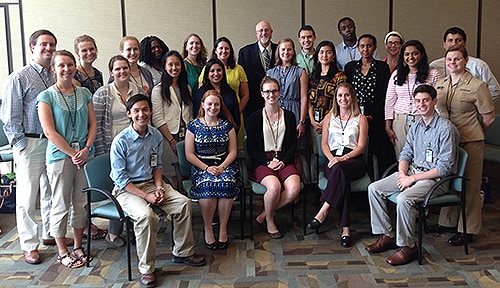Intern Project Page
The projects will change from year to year, but this page will give you an idea of the varied types of potential projects you could participate in.
- Relationship between Endocrine Disruptor Chemicals and the development of obesity
- An Environmental Scan of the US Indoor and Outdoor Air Pollution Policy Landscape
- Addressing Public Health through Healthy Community Design: Increasing Health Analysis in US Environmental Impact Assessment Activities
- Analysis of ATSDR’s Petitioned Public Health Assessment Response History
- ATSDR/NCEH Grant and Cooperative Agreement Cross-linking Project
- ATSDR Petition Program: Evaluation of ATSDR’s Potential Role in Addressing Community Concerns about Industrial Air Emissions
- Autism Spectrum Disorder: High-throughput Screening for Potential Candidate Genes and Etiologic Hazardous Agents of Environmental Origin.
- Climate Change and Public Health
- Connecting with Partners: A Land-use Agency Considers Health Impact Assessment
- Construction and Demolition Debris Landfill Initiative
- Developing an Environmental Odor Threshold Database
- Environmental Health Policy and ATSDR History
- Environmental Metrics for Community Health
- Environmental Public Health Equity Issues and Tribal Affairs
- Food and Nutritional Issues: Health Impact Assessments, Agriculture, Healthy Food Access, and Food Sourcing Guidelines
- Giardiasis’ Sensitivity to Climate Change
- Honey, I shrunk the titanium: Assessment of Engineered Nanomaterials and Strategic Planning for Nanotechnology Environmental Health Implications
- Identification of Populations at Increased Risk of Exposure to Automobile Pollution in Metropolitan Atlanta
- Integrating Environmental Health into Community Health Needs Assessments and Electronic Health Records
- Investigating Heat-related Illness among Migrant Farm Worker Populations in Southern Georgia
- Investigation and Communication of Drinking Water Exposures in the Navajo Nation
- Metabolism of Polychlorinated Biphenyls (PCBs) and Polychlorinated Biphenyls (PCBs) Congener Profiles in Humans
- Parks Benchmarking: A Nationwide Review of State Recreation Plans in Relation to Public Health
- Pilot Project for the Development of an Emergency Medical Infrastructure Assessment Tool
- Protecting Communities from Exposure to Naturally Occurring Asbestos
- Public Health Involvement in Brownfields and Land Reuse/ Redevelopment Decisions
- Real Environmental Health Action Created by Teens and Texts
- Research on Safety and Health in Manufactured Homes
- Sidewalk Walkability and Park Accessibility in Metropolitan Atlanta
- Telling the Stories of ATSDR’s Successes in Communities
- The Internet as a Communication Channel for Climate Change Information
- The National Conversation-Synthesizing Community Input
- Uranium Distribution within the Grants Mineral Belt, New Mexico and the Impact on Native American Populations
- Vapor Intrusion: Environmental Data analysis
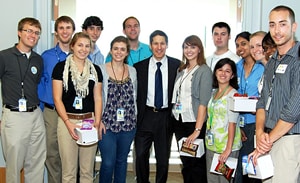
Project: Relationship between Endocrine Disruptor Chemicals and the development of obesity
The intern examined the potential role of endocrine disruptors chemicals in the development of obesity through conducting literature search, data mining, and bioinformatics tools focused on a life span view, epidemiological data, possible biologic pathways and environmental influences, and effects of environmental persistent pollutant. The intern made links between exposure to environmental chemicals and increased incidence of weight gain, glucose tolerance and insulin sensitivity, inflammation, and aspects of metabolic syndrome in animal models and human studies. This project provided a chance to discuss opportunities for new research to address exposure to endocrine disruptor chemicals mixtures associated with the development of obesity.
Project: An Environmental Scan of the US Indoor and Outdoor Air Pollution Policy Landscape
The intern researched and analyzed environmental policies and their impact across the country, and created a comprehensive inventory and summary of these findings. The purpose was to describe policies currently in place across the US, to note any trends observed among the policies that have been implemented, and analyze the relative successes and failures of these policies. The intern focused on the impact of these policies on human health or on their ability to impact human health. Sources searched included both national and local non-governmental organizations, case law, legislation (both pending and enacted), federal and state environmental and public health agencies, and other sources, as needed.
Project: Addressing Public Health through Healthy Community Design: Increasing Health Analysis in US Environmental Impact Assessment Activities
The intern helped the Healthy Community Design Initiative staff to 1. Develop a contact list of state and local environmental health directors for Health Impact Assessment activities. 2. Identify existing health standards that are relevant or related to decisions affecting land-use, transportation, and natural resource management. 3. Develop a FAQ/Answers sheet for Health Impact Assessment and Environmental Impact Assessment related questions. 4. Develop a set of form letters that summarize potential Health Impacts from common land-use actions that require Environmental Impact Assessments.
Project: Analysis of ATSDR’s Petitioned Public Health Assessment Response History
The intern analyzed the results of previous petition requests to address the questions: 1) How has ATSDR been most helpful to petitioner requests in the last few years and 2) How can ATSDR be a more helpful resource to communities with concerns about exposure to environmental contaminants released at a neighboring hazardous waste site? The intern also developed conclusions and recommendations based on the analysis regarding Petition Program policy modifications, in order to improve the efficacy of responses to future petition requests.
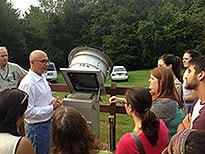
Project: ATSDR/NCEH Grant and Cooperative Agreement Cross-linking Project
The intern reviewed all current (Environmental Health) grants, cooperative agreements, and all other funding mechanisms available from NCEH and ATSDR that are awarded to external partners. The intern also helped develop a report on possible areas of collaboration among the different funding mechanisms. The intern conducted interviews, compiled data, and developed a final report of background on the programs and recommendations for collaboration.
Project: ATSDR Petition Program: Evaluation of ATSDR’s Potential Role in Addressing Community Concerns about Industrial Air Emissions
The intern helped identify, review, organize, and display the current policies and regulations used by EPA to ensure emissions from active industrial facilities are protective of public health and the environment. A major topic addressed in this project was the Clean Air Act. The analysis addressed the following questions. 1) How does EPA protect public health and the environment from contaminants in air emissions released from industrial operations? 2) How does the “permit” process work? 3) How can interested citizens learn more about the air emissions from active industrial facilities in their neighborhood? 4) How can interested citizens learn more about their exposure and the public health impact of contaminants released from active facilities into the air? 5) How can citizens voice concerns about the air emissions, including odors, from an active facility?
Project: Autism Spectrum Disorder: High-throughput Screening for Potential Candidate Genes and Etiologic Hazardous Agents of Environmental Origin.
The intern evaluated candidate genes and their interaction with potential environmental factors, in order to find a potential cause of autistic spectrum disorder or other neurological diseases that are the result of gene-environment interactions. The intern also used rapid-screening computational toxicology methodology, which can be applied to large numbers of environmental pollutants (ligands) in order to develop a known or suspected biological target for autism.
Project: Climate Change and Public Health
The intern provided literature scans and reviews assisting in the development of a journal article that addresses vulnerable populations and climate change. The intern also conducted research on heat waves and compiled this information along with other climate change related information into a Climate Change Speakers’ Resource LibraryExternal
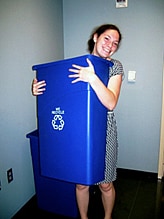
Project: Connecting with Partners: A Land-use Agency Considers Health Impact Assessment
The intern helped conduct a Rapid Health Impact Assessment (HIA) of Georgia’s newly adopted Statewide Comprehensive Outdoor Recreation Plan (SCORP), 2008-2013. The intern started conducting the rapid HIA, learned all the processes, and conducted the background research. The SCORP, however, did not pass the screening phase (1st phase) of an HIA so the HIA was not pursued further. The intern then put together a fact sheet for land use agencies on different approaches (HIA, evaluation) to looking at their programs.
Project: Construction and Demolition Debris Landfill Initiative
The intern served as a member of the C&D Landfill Workgroup. As a member of the Workgroup, they participated in monthly conference calls with federal and state partners. To assist the Workgroup in defining the extent of the potential health and environmental problems related to C&D landfills, the intern surveyed states to identify 1) the number of C&D landfills in their jurisdiction, 2) the number complaints received regarding C&D landfills, 3) whether the state or other agencies have investigated the human health impacts of living near a C&D landfill, and 4) whether states have enacted C&D related regulations. With this information, the intern worked with the Workgroup to draft guidance on how to assess and manage these types of operations.
Project: Developing an Environmental Odor Threshold Database
Environmental odors can be stressors, especially odors from landfills, industries, or confined animal feeding operations. Many scientific studies are beginning to find associations between environmental odors and health effects. At the very least, odors can adversely affect the quality of life of surrounding community members or be public nuisances. One CLEH intern worked in the Division of Community Health Investigations (DCHI) of the Agency for Toxic Substances and Disease Registry (ATSDR) to develop an Environmental Odors Database to be put on ATSDR’s Environmental Odors website. The database will be configured into a new search tool containing typical odor-onset levels (odor thresholds), occupational limits, minimal risk levels, target organs, chemical uses, and industries commonly associated with certain chemicals. The database and other information available on the existing Environmental Odors website offers approaches for reducing environmental odors in communities, steps for reporting environmental odor problems, methods for conducting odor complaint investigations, and ways for involving community members and other stakeholders in odor management decisions.
Project: Environmental Health Policy and ATSDR History
The intern researched the history of the Agency for Toxic Substances and Disease Registry from its beginning to its present day relationship with the National Center for Environmental Health. As part of this, the intern assisted in the development of a research paper detailing the origins of ATSDR, provided literature reviews, retrieved critical archival resources and references, performed historical reviews, and reviewed literature which contrasts public expectations about environmental sources of exposure to toxic chemicals with available scientific information.

Project: Environmental Metrics for Community Health
The intern assisted the Director with a project entitled MATCH- Mobilizing Action Toward Community Health. The intern assisted in writing an essay on metrics of the physical environment. Physical environmental metrics relevant to the health of a community include the usual environmental metrics like Air and water quality, and built environment as well as “upstream” factors that are indirectly but profoundly health related like carbon emissions and waste generation. The intern functioned as a research assistant pulling together the literature and helped draft the paper.
Project: Environmental Public Health Equity Issues and Tribal Affairs
The intern created a new, informative, user-friendly Office of Tribal Affairs newsletter and served as the policy lead for content areas and review within the newsletter. In this role the intern also assisted the Office of Tribal Affairs in facilitating a workshop titled, “Working Effectively with Tribal Governments.” The workshop conveyed general and practical information about working with American Indian and Alaska Native tribal governments, organizations, and communities. This training raised awareness and enhanced NCEH/ATSDR’s staff’s cultural competency of American Indian and Alaska Native issues.
Project: Food and Nutritional Issues: Health Impact Assessments, Agriculture, Healthy Food Access, and Food Sourcing Guidelines
The intern had the opportunity to assist in a variety of projects. 1) The intern assisted in incorporating food environment/ access questions to Health Impact Assessments. 2) The intern reviewed and collected articles on food animal feedlot pollution and environmental health for a literature review. 3) The interns assisted in created a section on rural/ agriculture in healthy communities for the Healthy Places website. 4) The intern helped to develop scientific rationale and justifications in food sourcing guidelines for procuring green and environmentally responsible food in the CDC food services. 5) The intern analyzed data in regards to healthy food access, the food environment, and food policies.
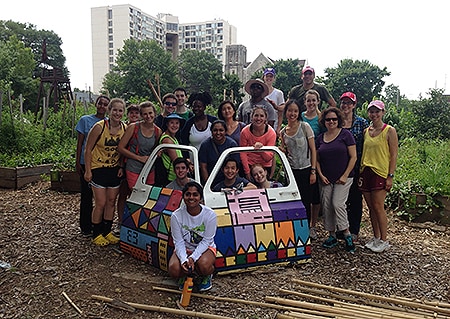
Project: Giardiasis’ Sensitivity to Climate Change
This project was done in partnership with the National Center for Zoonotic, Vector-Borne, and Enteric Diseases. The intern conducted a literature review to identify the potential effects that climate change could have on Giardia. The intern characterized the biological, ecological, and epidemiologic factors that influence transmission of the Giardiasis and identified the data gaps and research needed to further understand the climate sensitivity pattern of Giardiasis and its potential impact on human health. The intern helped to coordinate a webinar with state and local waterborne disease coordinators on climate change impacts.
Project: Honey, I shrunk the titanium: Assessment of Engineered Nanomaterials and Strategic Planning for Nanotechnology Environmental Health Implications
The intern provided time-critical support to the Nanotechnology Interest Group for addressing the lack of information on new nanomaterials in the market place. The primary activity of the intern was to conduct a systematic literature review of nanomaterial related toxicological data. This review identified five main knowledge gaps in nano-related epidemiological studies: toxicity of nanoparticles, transport/transformation, registry of exposed workers, exposed biomarkers and early effects, and impacts on general public/environmental health. From the review, the intern prioritized a few nanomaterials and developed specific toxicological frequently asked questions (ToxFAQs) fact sheets for the ATSDR website.
Project: Identification of Populations at Increased Risk of Exposure to Automobile Pollution in Metropolitan Atlanta
The intern assisted the Geospatial Research, Analysis, and Services Program (GRASP). The intern identified and evaluated populations at increased risk of exposure from automobile pollution given proximity to high density roads. Schools, daycares, and nursing homes and assisted living facilities were the initial focus of this investigation, as well as other vulnerable populations that were explored. The intern applied spatial techniques to identify and evaluate the distribution of school age children, and women >40 who had been shown to have increased risk of cardiovascular events and women of childbearing age at increased risk of low gestational weight or preterm birth given residential proximity to high density roads.
Project: Integrating Environmental Health into Community Health Needs Assessments and Electronic Health Records
The intern supported the Office of Science in reviewing the requirements and provisions of the Affordable Care Act (ACA), specifically in the context of environmental health. One such provision requires 501(c)3 designated hospitals to perform a Community Health Needs Assessment (CHNA) and develop related community focused strategies based on those results. The intern developed a report on how to effectively incorporate factors of the physical environment and the resulting implementation strategy of a CHNA for improving the overall health and well-being of the surrounding community. Additionally, the intern also provided research and collaboration with other experts to support the integration of individual environmental health data within Electronic Health Records.
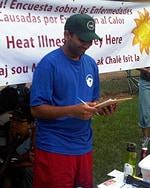
Project: Investigating Heat-related Illness among Migrant Farm Worker Populations in Southern Georgia
Migrant farm workers are at risk for heat-related illness. However, these workers may be unaware of the risks or are unable to access prevention measures at work, making them more susceptible to heat-related illnesses. The intern shared targeted, culturally appropriate messages for mitigating the impacts of heat and preventing heat-related morbidity and mortality with migrant communities (i.e., migrant worker populations and their families) of South Georgia. The intern then performed the initial data entry and provided an initial analysis of data to determine the knowledge, attitudes and practices regarding heat illness and barriers to its prevention among members these populations.
Project: Investigation and Communication of Drinking Water Exposures in the Navajo Nation
The intern assisted in creating and organizing participant response packets from and previous cross-sectional study. This entailed gathering appropriate educational material, coordinating results letters, creating visual handouts and educational presentations for communities and health workers. The intern traveled to Navajo Nation to assist in the training and notification efforts, which provided useful insight into the environmental health perspective of another culture.
Project: Metabolism of Polychlorinated Biphenyls (PCBs) and Polychlorinated Biphenyls (PCBs) Congener Profiles in Humans
The intern’s project focused on the events that direct the accumulation and the in vivo transformation of PCB congeners in human serum and milk and the mechanisms that determine those congener profiles. The intern’s work involved a literature review and analyses of the data to describe characteristic PCB congener levels. The intern plotted PCB exposure through several normalized studies against a standard curve representing a typical calculated adult dose of PCBs. Combination graphs were compared with another PCB exposure through breast milk to track bioaccumulation. The intern catalogued and compared PCB congener patterns in human serum and milk and described the activities of mammalian enzymes that bio-transform PCBs.
Project: Parks Benchmarking: A Nationwide Review of State Recreation Plans in Relation to Public Health
The intern performed a policy review on Statewide Comprehensive Outdoor Recreation Plans (SCORP’s) for all 50 states. The project goal was to investigate how SCORP’s can be used to address the relationship between parks and public health. The intern researched existing data to evaluate outdoor recreation resources by state, identified partners that support parks, trails and greenways and identified state or federal grants that could enhance and expand existing resources. Intern gained a deeper understanding of how the outdoor recreation system operates, its challenges and barriers and areas for growth and improvement.
Project: Pilot Project for the Development of an Emergency Medical Infrastructure Assessment Tool
The intern assisted in the development of a tool to assess the ability of a community’s emergency medical services to provide the necessary level of care in the event of a chemical mass casualty event. The project entailed identifying basic emergency medical services, identifying risks to the community related to the chemical facilities in the area, weighing the impact of various types of chemical mass casualty events, assessing the percent of the population impacted by each emergency medical service and identifying potential underserved populations in the area. The intern worked with the Geospatial Research, Analysis, and Service Program and Environmental Public Health Readiness Branch to learn GIS applications and the application of risk assessment techniques to assess public health capacity in a community.
Project: Protecting Communities from Exposure to Naturally Occurring Asbestos
The intern helped ATSDR in developing nationwide guidance on best practices to protect the public from harmful exposure to Naturally Occurring Asbestos. The intern searched for and compiled local and state rules and guidance related to asbestos and/or construction dust. This was done through Internet searches and calling local or state environmental, health, or planning departments. The intern researched methods specified in regulations for controlling releases of asbestos and/or dust. ATSDR was particularly interested in finding scientific articles and reports proving the effectiveness of dust control methods, such as wetting, in preventing releases of asbestos. ATSDR used the information gathered to make recommendations in national guidance and to identify gaps in research to be performed to determine method efficacy. The intern was also able to participate in a site visit.

Project: Public Health Involvement in Brownfields and Land Reuse/ Redevelopment Decisions
The intern assisted in the creation of 3 documents. 1) A manuscript on the past health assessment activities related to land reuse/ redevelopment decisions by ATSDR 2) A manuscript focusing on the criterion for citing daycares across the United States. The participant will help collect data for this manuscript by researching state guidance across the U.S. 3) A guidance document for addressing Brownfields in Alaska
Project: Real Environmental Health Action Created by Teens and Texts
The project involved the development of web based learning materials that will expand and strengthen environmental health literacy and leadership among adolescents (11-14 years old). The project also involved the development of a social networking mechanism to help keep learners engaged. The interns helped with the content research and translation of research into web-based educational content created a learning module on the topic of environmental justice.
Project: Research on Safety and Health in Manufactured Homes
Two interns participated in this project to help create a number of chapters for a white paper on health issues in manufactured homes. These chapters included information on mold and moisture, community settings, and emerging technologies. Both interns worked on the same project simultaneously, and attended a stakeholders meeting to present their findings after the internship ended.
Project: Sidewalk Walkability and Park Accessibility in Metropolitan Atlanta
The intern assisted the Geospatial Research, Analysis, and Services Program (GRASP). As part of a general effort to evaluate the effects of the built environment on health, the intern conducted research to evaluate sidewalk conditions and objective measures of neighborhood walkability as they contribute to park accessibility. As a result of this research, GRASP will not only characterize and quantify differences in methods used to describe service areas, but will develop objective measures of walkability applicable to evaluating other communities. The effort also involved the exploration of the effect of sidewalk conditions on walkability in communities that consist of minority populations or populations disproportionately affected by inequities in health services and disproportionately affected by adverse health outcomes and/or hazardous exposures.
Project: Telling the Stories of ATSDR’s Successes in Communities
Working with the Division of Community Health Investigations (DCHI) in the Agency for Toxic Substances and Disease Registry (ATSDR), one intern investigated stories of ATSDR’s successes in communities – instances where ATSDR staff went “above and beyond the call of duty” to ensure the safety and health of all. After reviewing countless ATSDR consultations and assessments of communities throughout the U.S., the intern identified what elements would make these stories interesting, engaging, and meaningful to multiple audiences. The intern then used these narratives to construct drafts of blog posts, fact sheets, and sound-bytes for the public and expert-level audiences. In addition, they used truncated versions of the stories within ATSDR’s budgetary Congressional Justification document in partnership with the Communications and Policy Offices.
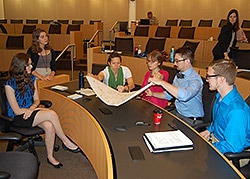
Project: The Internet as a Communication Channel for Climate Change Information
The intern assisted with developing a presentation on an environmental health Web game based on climate change and assisted with adding more information to the climate change Web site. The intern also restructured and reformatted some of the information on the climate change website in order to make it more readable and usable for the public.
Project: The National Conversation-Synthesizing Community Input
The intern served as a member of the National Conversation on Public Health and Chemical Exposures team and assisted in the coordination and analysis of information gathered through the project’s public engagement mechanisms. For example, the intern tracked, compiled, and analyzed feedback from more than 50 community conversations that included more than 1,000 people all over the U.S. This work has been used by decision makers to identify program and policy actions needed to improve the way we protect individuals, communities, and the nation from harmful chemical exposures.
Project: Uranium Distribution within the Grants Mineral Belt, New Mexico and the Impact on Native American Populations
The intern travelled to the Grants Mineral Belt in New Mexico and Arizona with ATSDR and EPA representatives. The Grants Mineral Belt contains large deposits of uranium that have been mined and milled for over 50 years. Many of these activities have taken place on Native American lands using Native American workers. The environmental impacts and public health impacts of these activities are enormous and the workers are eligible for federal compensation. The environmental impacts are just beginning to be evaluated by federal, state, and tribal authorities. The intern accompanied ATSDR officials as they conducted medical discussions with communities about the properties of uranium, how to test for uranium exposure and the possible health effects of exposure to uranium. The intern also interacted with the Navajo Nation and community members and consolidated documents related to geology, mining, environmental pathway analysis, and health impacts.
Project: Vapor Intrusion: Environmental Data analysis
The intern organized and analyzed environmental data from studies of vapor intrusion into buildings from groundwater sources. The intern also performed literature searches of environmental hazards from volatile chemicals and made a written summary and conclusion of the data analysis. The intern also traveled to a site with vapor intrusion and learned about environmental sampling.
